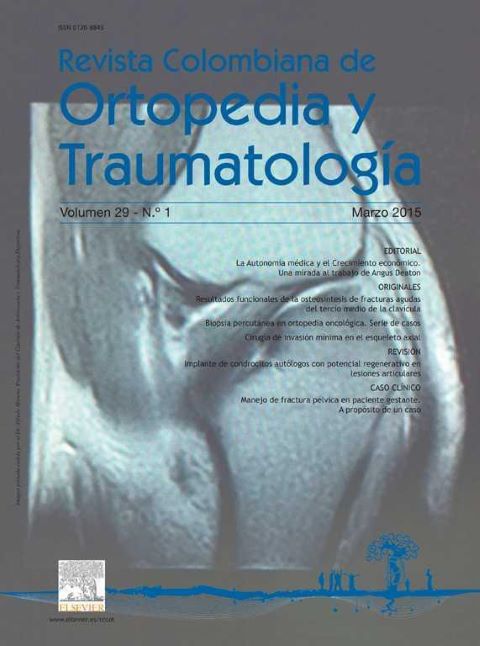Resultados funcionales de la osteosíntesis de fracturas agudas del tercio medio de la clavícula
DOI:
https://doi.org/10.1016/j.rccot.2015.10.006Palabras clave:
fractura de clavícula, reducción abierta y fijación internaResumen
Introducción: Las fracturas de clavícula han sido tratadas históricamente mediante diferentes tipos de inmovilización. Recientemente, el enfoque terapéutico ha ido cambiando hacia el manejo quirúrgico. El objetivo del estudio es determinar lo resultados de una cohorte de pacientes intervenidos quirúrgicamente para el tratamiento de fracturas de clavícula.
Materiales y métodos: Se realizó una cohorte longitudinal prospectiva, que incluía a 66 pacientes que fueron intervenidos quirúrgicamente por fracturas de clavícula en el período comprendido entre abril de 2009 y septiembre de 2010 mediante reducción abierta y fijación interna con placa anatómica bloqueada (LCP) para clavícula. Se hizo seguimiento de los 66 pacientes mediante la aplicación de la escala análoga visual de dolor (EVA) y la escala funcional de Constant, a las 6 semanas, 3 meses, 6 meses y al año del postoperatorio.
Resultados: Se presentaron cambios progresivos estadísticamente significativos con mejoría del dolor y funcionalidad en cada uno de los períodos de seguimiento (p < 0,001), sin cambios en la calificación del dolor entre el sexto mes y el año de seguimiento (p = 0,083). Del mismo modo fue evaluado el nivel de satisfacción en los pacientes intervenidos y en la mayoría de los casos se encontraron altos niveles de satisfacción en las escalas de Constant y en la EVA.
Discusión: Se puede concluir que la reducción abierta y la fijación interna de las fracturas de clavícula representan una excelente alternativa de tratamiento para este tipo de lesiones, con pronta y completa recuperación funcional y baja probabilidad de complicaciones.
Nivel de evidencia clínica: Nivel III.
Descargas
Referencias bibliográficas
Postacchini F, Gumina S, De Santis P, Albo F. Epidemiology of clavicle fracture. J Shoulder Elbow Surg. 2002;11:452-6. https://doi.org/10.1067/mse.2002.126613
Hill JM, McGuire MH, Crosby LA. Closed treatment of displaced middle third fracture of the clavicle gives poor results. J Bone Joint Surg Br. 2005;87-B:568-70.
Zlowodzki M, Zelle BA, Cole PA, Jeray K, McKee MD. EvidenceBased Orthopaedic Trauma Working Group. Treatment of midshaft clavicle fractures: systemic review of 2144 fractures: on behalf of the Evidence-Based Orthopaedic Trauma Working Group. J Orthop Trauma. 2005;19:504-7. https://doi.org/10.1097/01.bot.0000172287.44278.ef
Sharr JR1, Mohammed KD. Optimizing the radiographic technique in clavicular fractures. J Shoulder Elbow Surg. 2003;12:170-2. https://doi.org/10.1067/mse.2003.25
Nordqvist A, Petersson CJ, Redlund-Johnell I. Mid-clavicle fractures in adults: end result study after conservative treatment. J Orthop Trauma. 1998;12:572-6. https://doi.org/10.1097/00005131-199811000-00008
Hill JM, McGuire MH, Crosby LA. Closed treatment of displaced middle-third fractures of the clavicle gives poor results. J Bone Joint Surg Br. 1997;79:537-9. https://doi.org/10.1302/0301-620X.79B4.0790537
Lazarides S, Zafiropoulous G. Conservative treatment of fractures at the middle third of the clavicle: the relevance of shortening and clinical outcome. J Shoulder Elbow Surg. 2006;15:191-4. https://doi.org/10.1016/j.jse.2005.08.007
McKee MD, Wild LM, Schemitsch EH. Midshaft malunions of the clavicle. J Bone Joint Surg Am. 2003;85:790-7. https://doi.org/10.2106/00004623-200305000-00003
McKee MD, Wild LM, Schemitsch EH. Midshaft malunions of the clavicle. Surgical technique. J Bone Joint Surg Am. 2004;86 Suppl 1:37-43. https://doi.org/10.2106/00004623-200403001-00006
McKee MD, Pedersen EM, Jones C, Stephen DJ, Kreder HJ, Schemitsch EH, et al. Deficits following non-operative treatment of displaced midshaft clavicular fractures. J Bone Joint Surg Am. 2006;88:35-40. https://doi.org/10.2106/00004623-200601000-00005
Brinker MR, Edwards TB, O'Connor DP. Letter regarding estimating the risk of nonunion following nonoperative treatment of a clavicular fracture. J Bone Joint Surg Am. 2005;87:676-7. https://doi.org/10.2106/00004623-200503000-00034
Robinson CM, Court-Brown CM, McQueen MM, Wakefield AE. Estimating the risk of non-union following nonoperative treatment of a clavicular fracture. J Bone Joint Surg Am. 2004;86: 1359-65. https://doi.org/10.2106/00004623-200407000-00002
Wick M, Muller EJ, Kollig E, et al. Midshaft fractures of the clavicle with a shortening of more than 2 cm predispose to nonunion. Arch OrthopTrauma Surg. 2001;121:207-11. https://doi.org/10.1007/s004020000202
Jhonston RM. Clavicle fractures: non union. Orthopedic hiperguide. http://www.ortho.hyperguides.com/Jun 2005.
Hill JM, McGuire MH, Crosby LA. Closed treatment of displaced middle - third fractures of the clavicle gives poor results. J Bone Joint Surg Br. 2005;79-B:537-40. https://doi.org/10.1302/0301-620X.79B4.0790537
Muller SD, Maiyah MA, Hui AC, Adedapo AO. Thoracic penetration following mid-shaft clavicular fracture. J Bone Joint Surg Br. 2005;87-B:568-70. https://doi.org/10.1302/0301-620X.87B4.15861
Schwarz N, Hocker K. Osteosynthesis of irreducible fractures of the clavicle with 2.7 - MM ASIF plates. J Trauma. 1992;33:179-83. https://doi.org/10.1097/00005373-199208000-00003
Doro C, Hayden RJ, Louis DS. Complex regional pain syndrome type I in the upper extremity. Clin Occup Environ Med. 2006;5:445-54.
McKee MD, Seiler JG, Jupiter JB. The application of the limited contact dynamic compression plate in the upper extremity: an analysis of 114 consecutive cases. Injury. 1995;26:661-6. https://doi.org/10.1016/0020-1383(95)00148-4
Marti RK, Nolte PA, Kerkhoffs GM, et al. Operative treatment of mid-shaft clavicular non-union. Int Orthop. 2003;27:131-5. https://doi.org/10.1007/s00264-002-0424-7
Zlowdzki M, Zelle BA, Cole PA, et al. Treatment of acute midshaft clavicle fractures: systematic review of 2144 fractures: on behalf of the evidence-based orthopaedic trauma working group. J Orthop Trauma. 2005;19:504-7. https://doi.org/10.1097/01.bot.0000172287.44278.ef
Gordon J. The bony anatomy of clavicular malunions. J Shoulder Elbow Surg. 2003;12:173-8. https://doi.org/10.1067/mse.2003.2
Jubel A, Andermahr J, Schiffer G, Tsironis K, Rehm KE. Elastic stable intramedullary nailing of midclavicular fractures with a titanium nail. Clin Orthop Relat Res. 2003;408:279-85. https://doi.org/10.1097/00003086-200303000-00037
Yian EH, Ramappa AJ, Arneberg O, Gerber C. The Constant score in normal shoulders. J Shoulder Elbow Surg. 2005;14:128-33. https://doi.org/10.1016/j.jse.2004.07.003
Marsh JL, Slongo TF, Agel J, Scott Broderick J, Creevey W, DeCoster TA, et al. Fracture and dislocation classification compendium - 2007: Orthopaedic Trauma Classification, Database and Outcomes Committee. J Orthopaed Trauma. 2007;21:S72-4. https://doi.org/10.1097/00005131-200711101-00001
Fabre T, Piton C, Leclourec G, Gervais-Delion F, Durandeau A. Entrapment of the subescapular nerve. J Bone Joint Sur Br. 1999;B1:4414-8.
Nowak J, Holgersson M, Larsson S. Can we predict long-term sequelae after fractures of the clavicle based on initial findings? A prospective study with nine to ten years of follow-up. J Shoulder Elbow Surg. 2004;13:479-86. https://doi.org/10.1016/j.jse.2004.01.026
Boehme D, Curtis RJ Jr, DeHaan JT, Kay SP, Young DC, Rockwood CA Jr. Nonunion of fractures of the mid-shaft of the clavicle. Treatment with a modified Hagie intramedullary pin and autogenous bone-grafting. J Bone Joint Surg Am. 1991;73:1219-26. https://doi.org/10.2106/00004623-199173080-00012
Kabak S, Halici M, Tuncel M, et al. Treatment of midclavicular nonunion: comparison of dynamic compression plating and contact dynamic compression plating techniques. J Shoulder Elbow Surg. 2004;13:396-404. https://doi.org/10.1016/j.jse.2004.01.033
Drosdowech S, Stuart E, Manwell E, Ferreira L, BS Da Goel D, Faber K, et al. Biomechanical analysis of fixation of middle third fractures of the clavicle. J Orthop Trauma. 2011;25:39-43. https://doi.org/10.1097/BOT.0b013e3181d8893a
Del Gordo RJ, Habeych A, Castillo FG, Trout GO. Fracturas de clavícula. Tratamiento quirúrgico con clavos intramedulares flexibles. Rev Duazary. 2006;2:115-20.
Ring D, Holovacs T. Brachial plexus palsy after intramedullary fixation of a clavicular fracture. A report of three cases. J Bone Joint Surg Am. 2005;87:1834-7. https://doi.org/10.2106/00004623-200508000-00025
Canadian Orthopaedic Trauma Society. Nonoperative treatment compared with plate fixation of displaced midshaft clavicular fractures. A multicenter randomized clinical trial. J Bone Joint Surg Am. 2007;89:1-10. https://doi.org/10.2106/JBJS.F.00020
Heritier SR, Gebski VJ, Keech AC. Inclusion of patients in clinical trial analysis: the intention-to-treat principle. Med J Aust. 2003;179:438-40. https://doi.org/10.5694/j.1326-5377.2003.tb05627.x
Descargas
Publicado
Cómo citar
Número
Sección
Licencia
Derechos de autor 2024 Revista Colombiana de ortopedia y traumatología

Esta obra está bajo una licencia Creative Commons Reconocimiento 3.0 Unported.








